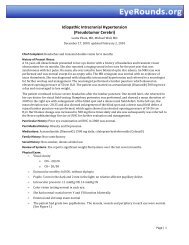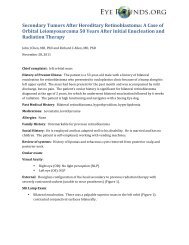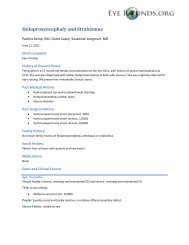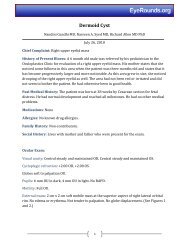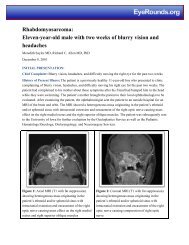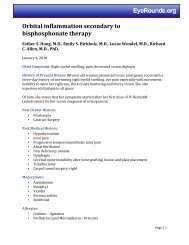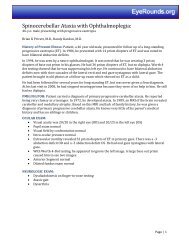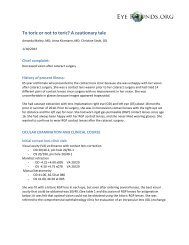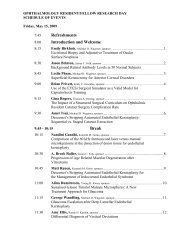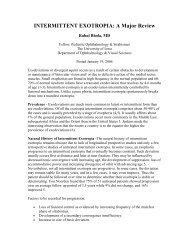Plateau Iris - Ophthalmology and Visual Sciences
Plateau Iris - Ophthalmology and Visual Sciences
Plateau Iris - Ophthalmology and Visual Sciences
You also want an ePaper? Increase the reach of your titles
YUMPU automatically turns print PDFs into web optimized ePapers that Google loves.
<strong>Plateau</strong> <strong>Iris</strong><br />
Gina M. Rogers, MD, Wallace L. M. Alward, MD, <strong>and</strong> John H. Fingert, MD, PhD<br />
December 21, 2011<br />
Chief Complaint: Referral for evaluation of glaucoma<br />
History of Present Illness: A healthy 47-year-old woman with no family history of glaucoma was referred<br />
for possible glaucoma. She denied any visual complaints.<br />
Past Ocular History: Hyperopia <strong>and</strong> presbyopia<br />
Past Medical History: Iron deficiency anemia secondary to uterine fibroid<br />
Ocular Examination:<br />
<strong>Visual</strong> acuity with correction<br />
MRx:<br />
OD: 20/20-1<br />
OS: 20/20<br />
OD: +2.50 +0.25 x086<br />
OS: +2.75 +0.25 x004<br />
Pupils: symmetric, briskly reactive <strong>and</strong> there is no relative afferent pupillary defect OU<br />
<strong>Visual</strong> Fields: full by confrontation OU<br />
Intraocular Pressure by Applanation Tonometry<br />
OD: 11 mm Hg; pachymetry 541 micrometers<br />
OS: 13 mm Hg; pachymetry 543 micrometers<br />
Anterior Segment Examination:<br />
Conjunctiva: normal<br />
Cornea: clear without Kruckenberg spindle or endothelial changes<br />
<strong>Iris</strong>: normal architecture without heterochromia or transillumination defects<br />
Anterior chamber: narrow angles by Van Herrick<br />
Lens: Clear OU<br />
Gonioscopy (Spaeth classification):<br />
OD: Temporal (B) C 30P+1 Nasal (B) C 30P+1 Superior (B) C 30P+1 Inferior (B) C 30P+1<br />
OS: Temporal (B) C 20P+1 Nasal (B) C20P+1 Superior (B) C 20P+1 Inferior (B) C 30P+1
Figure 1: View through Goldmann 3 mirror<br />
The iris drapes over the ciliary body producing the characteristic “sine<br />
wave” or double-hump.<br />
Video may be accessed from<br />
• eyerounds.org/cases-i/case143/<strong>Plateau</strong>-<strong>Iris</strong>-01.wmv<br />
• youtu.be/Qx9Ddkjq7iQ<br />
Video: first note the anterior chamber is shallow by Van Herrick. On<br />
indentation gonioscopy, the “double hump” is observed.<br />
Figure 2: Anterior Segment OCT: Pre-Laser peripheral iridotomy (LPI)<br />
Figure 3: Anterior Segment OCT: Post-LPI, note widening of the angle<br />
- 2 -
Figure 4: Ultrasound biomicroscopy:<br />
The anterior position of the ciliary body pushes the peripheral iris against<br />
the trabecular meshwork.<br />
Course: This patient was initially treated with LPIs in each eye. Her angle depth improved in each eye but<br />
there was concern that the angle in the left eye was still occludable . She underwent a laser iridoplasty OS<br />
without complication <strong>and</strong> repeat gonioscopy demonstrated improvement in the angle depth OS. At present,<br />
the angle in the right eye does not appear to be occludable <strong>and</strong> we are monitoring her with repeat gonioscopy<br />
exams every 6 months.<br />
Discussion: <strong>Plateau</strong> iris syndrome is a relatively uncommon form of primary angle closure glaucoma that is<br />
seen more often in younger adults than pupillary block angle-closure glaucoma. It is caused by large or<br />
anteriorly positioned ciliary processes that push the peripheral iris forward. The mechanical position of the<br />
ciliary processes against the trabecular meshwork crowds the angle <strong>and</strong> obstructs aqueous outflow. A<br />
component of pupillary block is often present.<br />
The central anterior chamber may appear to be of normal depth on slit lamp examination. On examination<br />
with gonioscopy, the iridocorneal angle is usually crowded or even closed. The iris typically appears to have a<br />
flat approach (on a plane to intersect Schwalbe’s line) with a steep drop-off just before the trabecular<br />
meshwork. On indentation gonioscopy the “sine wave” or “double-hump sign” is seen. The peripheral “hump”<br />
is created by the iris draping over the ciliary body <strong>and</strong> the more central hump by the iris curving over the<br />
anterior lens surface.<br />
Ancillary imaging modalities can be helpful in making the diagnosis of plateau iris. Ultrasound biomicroscopy<br />
can provide information of the anterior segment anatomy as well as help confirm any element of pupillary<br />
block. Anterior segment optical coherence tomography (OCT) can also provide insight into the anatomy, but it<br />
is not a dynamic examination <strong>and</strong> does not provide as much information as gonioscopy.<br />
Treatment:<br />
Some element of pupillary block frequently exists in patients with plateau iris configuration <strong>and</strong> generally,<br />
peripheral laser iridotomy should be performed as the first intervention in patients suspected of having<br />
plateau iris. This often times is an adequate treatment for eyes with plateau iris configuration. However a<br />
subset of patients will have a persistent occludable angle despite a patent iridotomy causing plateau iris<br />
syndrome. Eyes where the iridocorneal angle has persistent apposition or the intraocular pressure remains<br />
- 3 -
elevated should be treated with laser iridoplasty. The goal of laser iridoplasty is to place laser burns at the<br />
peripheral iris to shrink the iris <strong>and</strong> pull it from the angle. Of course, if laser surgical treatment is ineffective<br />
in controlling the intraocular pressure, conventional surgical procedures such as a trabeculectomy or a tubeshunt<br />
may need to be implemented.<br />
Laser settings recommended by Wallace L.M. Alward, MD in Glaucoma: The Requisites in <strong>Ophthalmology</strong>.<br />
Laser Iridotomy:<br />
Argon Laser Peripheral Iridotomy:<br />
Spot size: 50 micrometers<br />
Duration: 0.02-0.2 seconds<br />
Power: 1 Watt<br />
Lens: Abraham or Wise<br />
Nd:Yag Laser Peripheral Iridotomy<br />
Spot size: fixed<br />
Duration: fixed<br />
Energy: 1-12 mJoules<br />
Lens: Abraham or Wise<br />
Argon Laser Iridoplasty:<br />
Spot size; 200-500 micrometers<br />
Duration: 0.2-0.5 seconds<br />
Power 150-300 mWatt<br />
Lens: none or Goldmann 3 mirror<br />
Note: larger spot size <strong>and</strong> longer duration<br />
Diagnosis: <strong>Plateau</strong> <strong>Iris</strong> Syndrome<br />
Differential Diagnosis<br />
“Pseudo plateau iris” caused by iris cysts or ciliary body cysts<br />
Primary angle closure<br />
Pupillary block<br />
Peripheral anterior synechiae<br />
- 4 -
Epidemiology<br />
• Exact incidence is not well known<br />
• Diagnosis should be suspected when angle<br />
closure occurs in patient who is young or myopic<br />
<strong>and</strong> when angle narrowing persists despite<br />
iridotomy<br />
• Generally occurs in younger age group vs.<br />
primary pupillary block glaucoma. Average age<br />
30-50s<br />
• Slight female <strong>and</strong> hyperopic preponderance<br />
Symptoms<br />
• May present with angle closure, either<br />
spontaneously or after pupillary dilation<br />
• More commonly, patients are asymptomatic <strong>and</strong><br />
the diagnosis is made on routine examination<br />
Additional Resources available at www.gonioscopy.org<br />
- 5 -<br />
Signs<br />
• Narrowed or closed angle with iris on a plane to<br />
intersect with Schwalbe’s line then with a sharp<br />
drop-off of the peripheral iris<br />
• Indentation gonioscopy reveals the “doublehump”<br />
sign<br />
Treatment<br />
• Often an element of pupillary block exists so laser<br />
peripheral iridectomy is indicated<br />
• If not improvement in appearance of the angle<br />
laser iridoplasty to contract the peripheral,<br />
pulling the iris away from the crowded angle<br />
References:<br />
Alward WLM. Glaucoma: The Requisites in <strong>Ophthalmology</strong>. Mosby 2000. Pages 146-7 <strong>and</strong> 209-213.<br />
Kiuchi Y, Kanamoto T, Nakamura T. Double hump sign in indentation gonioscopy is correlated with<br />
presence of plateau iris configuration regardless of patent iridotomy. J Glaucoma. 2009; 18(2):161-164.<br />
Shukla S, Damji KF, Harasymowycz P, Chialant D, Kent JS, Chevrier R, Buhrmann R, Marshall D, Pan Y,<br />
Hodge W. Clinical features distinguishing angle closure from pseudoplateau versus plateau iris. Br J<br />
Ophthalmol. 2008; 92(3):340-344.<br />
Ritch R, Tham CC, Lam DS. Argon laser peripheral iridoplasty (ALPI): an update. Surv Ophthalmol. 2007;<br />
52(3):279-88.<br />
Leung CK, Chan WM, Ko CY, Chui SI, Woo J, Tsang MK, Tse RK. <strong>Visual</strong>ization of anterior chamber angle<br />
dynamics using optical coherence tomography. <strong>Ophthalmology</strong>. 2005; 112(6):980-984.<br />
Ritch R, Tham CC, Lam DS. Long-term success of argon laser peripheral iridoplasty in the management<br />
of plateau iris syndrome. <strong>Ophthalmology</strong>. 2004; 111(1):104-108.<br />
W<strong>and</strong> M, Pavlin CJ, Foster FS. <strong>Plateau</strong> iris syndrome: ultrasound biomicroscopic <strong>and</strong> histologic study.<br />
Ophthalmic Surg. 1993; 24(2):129-131.<br />
Suggested Citation Format:<br />
Rogers GM, Alward, WLM, Fingert JH. <strong>Plateau</strong> <strong>Iris</strong>. EyeRounds.org. December 21, 2011; Available from:<br />
http://EyeRounds.org/cases/143-plateau-iris.htm



